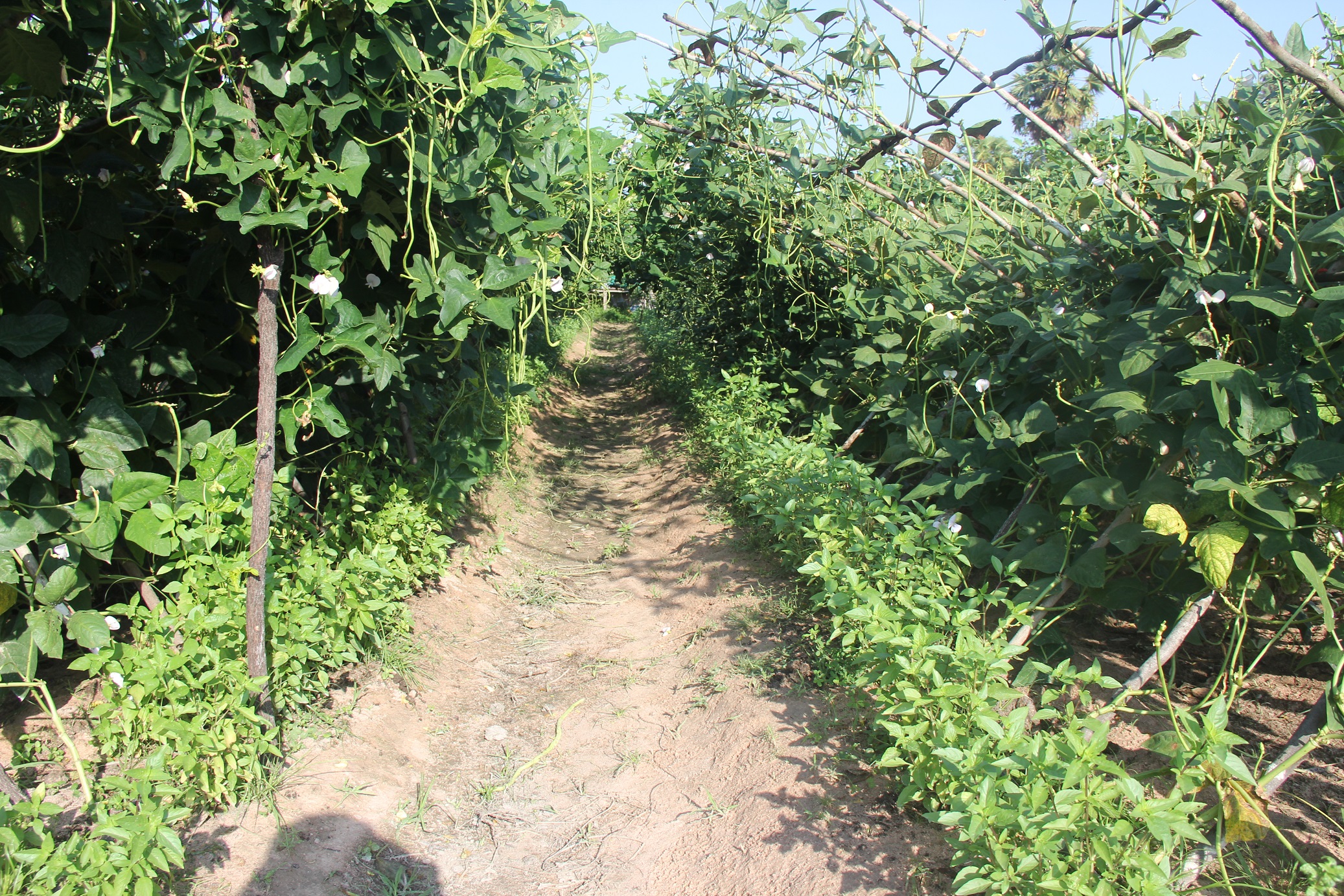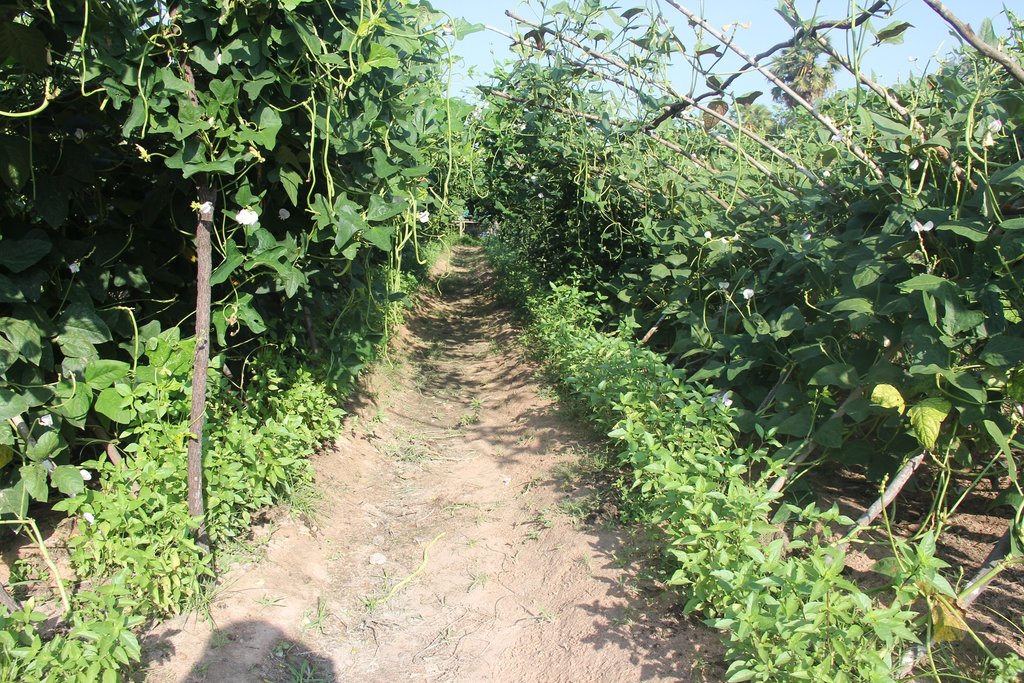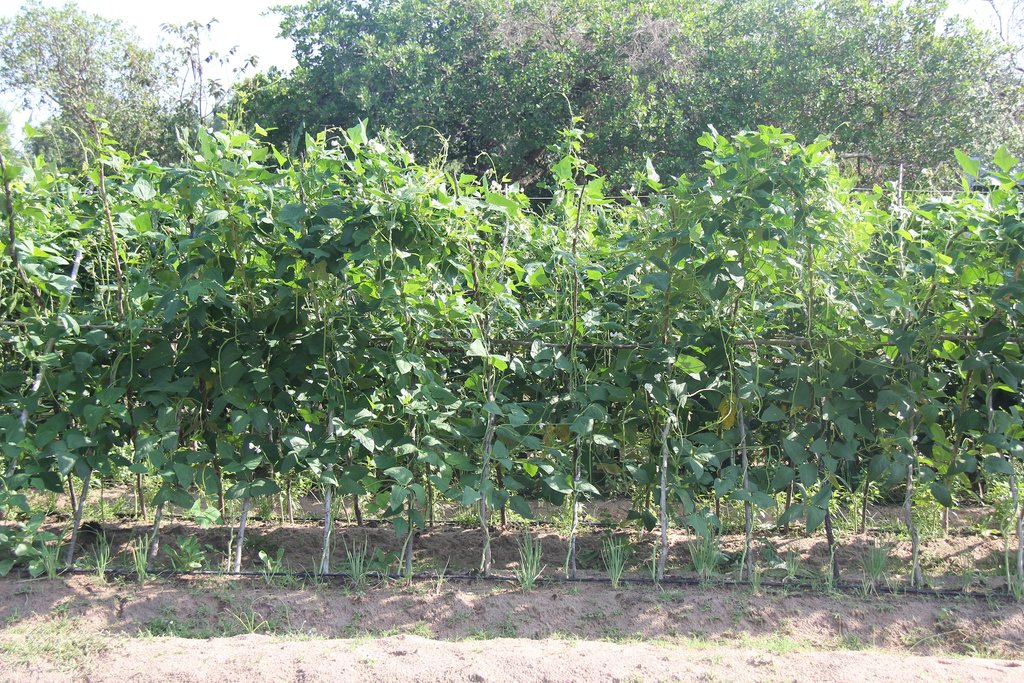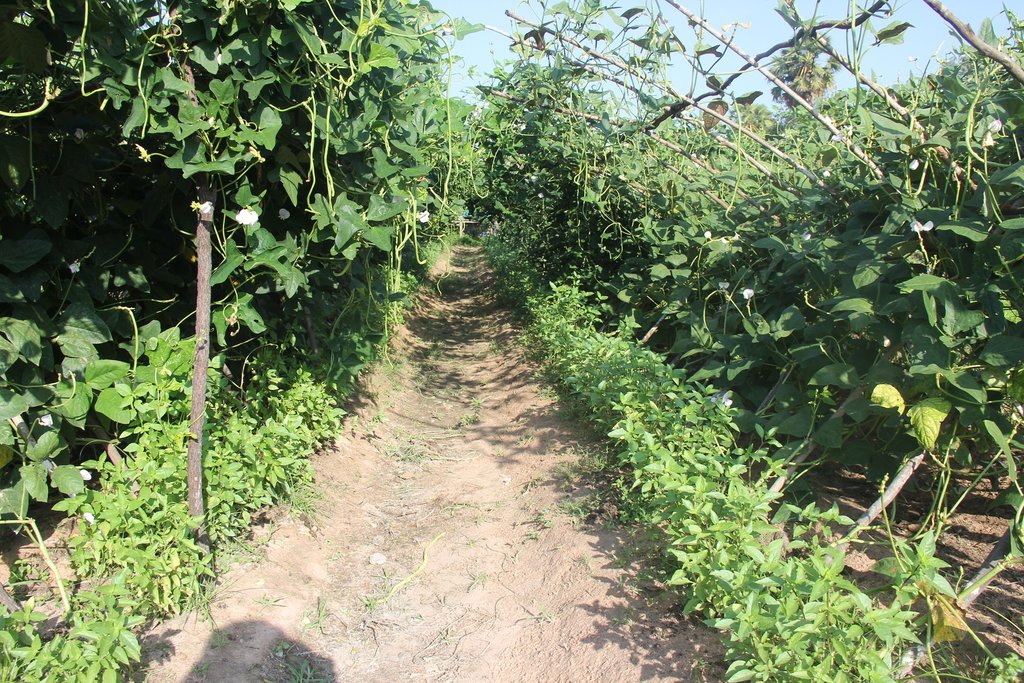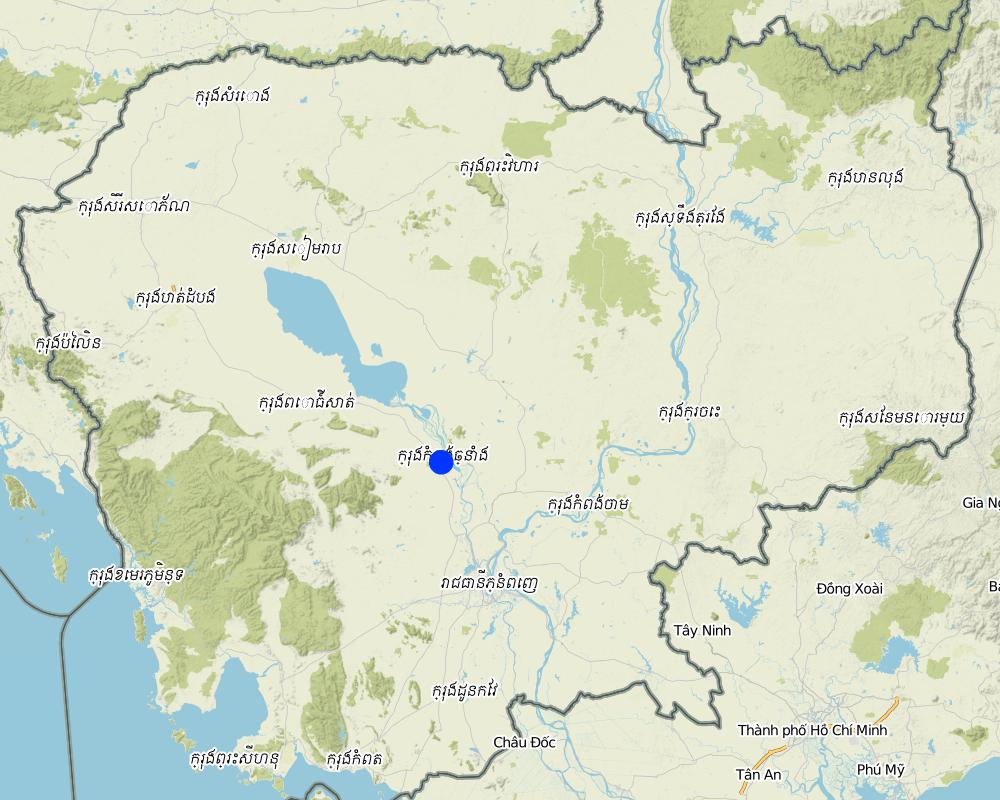Sandy soil improvement by using natural fertilizer and liquid compost [Cambodia]
- Creation:
- Update:
- Compiler: Be Gechkim
- Editors: Navin Chea, Sophea Tim, Sok Pheak
- Reviewers: Nimul CHUN, Ursula Gaemperli, Alexandra Gavilano
Long bean plantation
technologies_2949 - Cambodia
View sections
Expand all Collapse all1. General information
1.2 Contact details of resource persons and institutions involved in the assessment and documentation of the Technology
Key resource person(s)
land user:
Phally Chan
Farmer
Cambodia
Vice Chief of Agronomy Office at District Office of Agriculture, Forestry and Fisheries, Rolea B'ies:
Bunleang Chhim
Office of Agriculture, Forestry and Fisheries Rolea B'ier District
Cambodia
Vice Chief of Extension Office of Provincial Department of Agriculture, Forestry and Fisheries, Kampong Chhnang Province:
Chief of District Office Agriculture, Forestry and Fisheries, Tuek Phos:
1.3 Conditions regarding the use of data documented through WOCAT
The compiler and key resource person(s) accept the conditions regarding the use of data documented through WOCAT:
Yes
1.4 Declaration on sustainability of the described Technology
Is the Technology described here problematic with regard to land degradation, so that it cannot be declared a sustainable land management technology?
No
Comments:
This technique can be classified as a sustainable land management. Formerly this land type was almost completely sandy and thus, not suitable to grow crops even water morning glory, but after using natural fertilizers and liquid compost, crops were planted and provided good yields.
2. Description of the SLM Technology
2.1 Short description of the Technology
Definition of the Technology:
The practice of improving the conditions of a sandy soil by natural fertilizers and liquid compost application increases the crop production, as it leads to a substantial improvement of the soil quality. It improves the water retention capacity, improves the soil structure (less compaction), eases the nutrient absorption and finally, increases the soil fertility in general.
2.2 Detailed description of the Technology
Description:
A sandy soil is a soil type with large particles that has difficulty in retaining both moisture and fertility, which makes it challenging for crop cultivation. Therefore, a practice is needed that helps farmer to improve the quality of such soils. Improving soil quality means to promote a process of constant improvement of soil fertility by maintaining soil moisture, reducing soil compaction, and support to better nutrient absorption, thereby finally promoting better plant growth. Sandy soils are relatively compact and can hamper the growth and penetration of plant roots, what hinders the absorption of nutrients. To reduce this effect, the incorporation of organic matter can be useful (Rhoades, 2016). The farmers have their own techniques to improve sandy soils; one example is the diversified crop cultivation by using natural fertilizer and liquid compost. This technology is applied by one of farmers in the Prey Puoch village, belonging to the Rolea B'ier District.
His objective was to improve sandy soils in order to achieve higher production. Apart of the application of liquid compost and natural fertilizers ‒ and consequently the improvement of the soil nutrient status ‒ the farmer also increased the range of crops to raise the production level. Therefore, the family was able to raise its surpluses to be sold at the markets significantly. This led to a meaningful improvement of the livelihood.
The farmer use only natural fertilizers, such as crops residue, and cow manure or manure from pigs, when cow manure is not available. Although pig manure does not contain the same high level of nutrients as cow manure, it helps to reduce soil compaction, allows crop’s roots to absorb nutrients, and improves soil moisture. In addition, liquid compost can be applied to increase soil fertility, as this kind of compost is rich in microorganisms that play an important role in the decomposition of organic materials. By this, nutrients can be provided in the best possible way. The farmer has planted long beans and other trellising plants in rotation and as inter-crops for example strongly smelling spring onion and anise basil. Such crops grown beneath the long beans can help to reduce pest damage and diminish the use chemical pesticides. Plating anise basil and spring onions along each long bean row and the rotation practices also help maintaining the nutrition level in the soil.
To make liquid compost the farmer uses two main ingredients, such as animal (poultry) manure and plant leaves (Siam weed, Cassia tree, Lead tree, Sesbania, etc.). All of the materials are chopped and mixed, and then put into a big jar with 20 times the volume of water being added. The jar is then closed to reduce the unpleasant smell. The mixture is stirred twice daily to provide enough oxygen for the microorganisms. After three weeks the liquid mixture will be no longer smelly, and will be ready for use as liquid compost. This compost is applied three times during the crop cycle: at the start of planting, just before the flowering stage, and at the production stage. The ratio of application is 1 liter of the liquid compost for each square meter of land (Yang and Pean, 2015).
Before the farmer adopted this technology they could not even grow water morning glory and they needed a lot of labor and much water for the irrigation. This practice not only helps to improve soil quality, it reduces also the costs by using less chemical fertilizers and pesticides, by reducing the labour input, and it helps to expand the area of arable land.
2.3 Photos of the Technology
2.4 Videos of the Technology
Comments, short description:
N/A
Name of videographer:
N/A
2.5 Country/ region/ locations where the Technology has been applied and which are covered by this assessment
Country:
Cambodia
Region/ State/ Province:
Prey Puoch village, Chrey Bak commune, Rolea B'ier District, Kampong Chhnange province
Specify the spread of the Technology:
- evenly spread over an area
If the Technology is evenly spread over an area, specify area covered (in km2):
0.00036
Comments:
This technique is applied on an area size of 12 x 30 meters.
Map
×2.6 Date of implementation
Indicate year of implementation:
2016
2.7 Introduction of the Technology
Specify how the Technology was introduced:
- through land users' innovation
Comments (type of project, etc.):
The farmer was formerly an agricultural extension worker with full of experience.
3. Classification of the SLM Technology
3.1 Main purpose(s) of the Technology
- improve production
- reduce, prevent, restore land degradation
- create beneficial economic impact
3.2 Current land use type(s) where the Technology is applied

Cropland
- Annual cropping
Annual cropping - Specify crops:
- legumes and pulses - beans
- medicinal/ aromatic/ pesticidal plants and herbs
- vegetables - root vegetables (carrots, onions, beet, other)
Number of growing seasons per year:
- 3
Specify:
Long bean can be harvested after 60 to 65 days after planting and for 15 to 18 times per cycle. Anise Basil can be harvested after 25 days. Spring onion can harvested after 30 days after planting and the harvest continues for around 1.5 months (around 10 to 20 times per cycle).
Comments:
There are three types of crops such as Long bean, Anise Basil and Spring onion.
3.3 Has land use changed due to the implementation of the Technology?
Has land use changed due to the implementation of the Technology?
- Yes (Please fill out the questions below with regard to the land use before implementation of the Technology)

Cropland
Comments:
Rice field with low yield due to the sandy soil
3.4 Water supply
Water supply for the land on which the Technology is applied:
- mixed rainfed-irrigated
Comments:
Getting water for irrigation from a pond and drill well
3.5 SLM group to which the Technology belongs
- rotational systems (crop rotation, fallows, shifting cultivation)
- integrated soil fertility management
- integrated pest and disease management (incl. organic agriculture)
3.6 SLM measures comprising the Technology

agronomic measures
- A1: Vegetation/ soil cover
- A2: Organic matter/ soil fertility

structural measures
- S7: Water harvesting/ supply/ irrigation equipment
3.7 Main types of land degradation addressed by the Technology

chemical soil deterioration
- Cn: fertility decline and reduced organic matter content (not caused by erosion)

water degradation
- Ha: aridification
3.8 Prevention, reduction, or restoration of land degradation
Specify the goal of the Technology with regard to land degradation:
- restore/ rehabilitate severely degraded land
Comments:
To improved soil quality, composting with cow manure, poultry and pig manure, and combination of soil from termite mound for plantation to improved soil quality.
4. Technical specifications, implementation activities, inputs, and costs
4.1 Technical drawing of the Technology
Technical specifications (related to technical drawing):
This technique is applied on the land with 24 x 52 meters land that contains a pond at the back of the field (22 x 34 meters width and length respectively and 5 meters depth). The remaining land is covered by long bean, 12 x 30 meters with rows of long bean is 1.7 meters wide, row gap is 1.5 meters, height is 30 centimeters, and 40 cm space between plant to plant is. On the size is cover by long bean 3 rows as 6 lines, each rows are 40 centimeters gap with anise basil plantation and spring onion between long bean. To make liquid compost the farmer uses two main ingredients, such as animal (poultry) manure and plant leaves (Siam weed, Cassia tree, Lead tree, Sesbania, etc.). All of the materials are chopped and mixed, and then put into a big jar with 20 times the volume of water being added. The jar is then closed to reduce the unpleasant smell. The mixture is stirred twice daily to provide enough oxygen for the microorganisms. After three weeks the liquid mixture will be no longer smelly, and will be ready for use as liquid compost. This compost is applied three times during the crop cycle: at the start of planting, just before the flowering stage, and at the production stage. The ratio of application is 1 liter of the liquid compost for each square meter of land.
Author:
Mr. Khuon Sophal
Date:
25/05/2017
4.2 General information regarding the calculation of inputs and costs
Specify how costs and inputs were calculated:
- per Technology area
Indicate size and area unit:
12 X 30 = 360 square meters
other/ national currency (specify):
KHR
If relevant, indicate exchange rate from USD to local currency (e.g. 1 USD = 79.9 Brazilian Real): 1 USD =:
4000.0
Indicate average wage cost of hired labour per day:
25000 Riel
4.3 Establishment activities
| Activity | Timing (season) | |
|---|---|---|
| 1. | Ploughing | May |
| 2. | Lime spreading | May |
| 3. | Row preparation | May |
| 4. | Putting cow manure and fertiled soil | May |
| 5. | Installation of drip irrigation system | May |
| 6. | Do the trellising | May |
| 7. | Do the nursery | May |
4.4 Costs and inputs needed for establishment
| Specify input | Unit | Quantity | Costs per Unit | Total costs per input | % of costs borne by land users | |
|---|---|---|---|---|---|---|
| Labour | Ploughing | times | 3.0 | 20000.0 | 60000.0 | 100.0 |
| Labour | Rows preparation and lime spreading | day | 2.0 | 25000.0 | 50000.0 | 100.0 |
| Labour | Preparing drip irrigation | day | 1.0 | 25000.0 | 25000.0 | 100.0 |
| Equipment | Spade | piece | 1.0 | 15000.0 | 15000.0 | 100.0 |
| Equipment | Hoe | piece | 1.0 | 20000.0 | 20000.0 | 100.0 |
| Equipment | Shovel | piece | 1.0 | 20000.0 | 20000.0 | 100.0 |
| Plant material | Long bean seeds | package | 1.0 | 10000.0 | 10000.0 | 100.0 |
| Plant material | Spring onion seeds | kg | 3.0 | 4000.0 | 12000.0 | 100.0 |
| Plant material | Tray seeding | piece | 6.0 | 4000.0 | 24000.0 | 100.0 |
| Fertilizers and biocides | Cow manure | ox-driven vehicle | 6.0 | 20000.0 | 120000.0 | 100.0 |
| Fertilizers and biocides | DAP fertilizer | kg | 5.0 | 3000.0 | 15000.0 | 100.0 |
| Fertilizers and biocides | KCL fertilizer | kg | 5.0 | 3000.0 | 15000.0 | 100.0 |
| Fertilizers and biocides | Urea fertilizer | kg | 5.0 | 3500.0 | 17500.0 | 100.0 |
| Construction material | Drip system | set | 1.0 | 110000.0 | 110000.0 | 100.0 |
| Construction material | Pipe | piece | 2.0 | 20000.0 | 40000.0 | 100.0 |
| Construction material | Branches for trellising | piece | 225.0 | 300.0 | 67500.0 | 100.0 |
| Construction material | Small water tank | piece | 2.0 | 6000.0 | 12000.0 | 100.0 |
| Total costs for establishment of the Technology | 633000.0 | |||||
| Total costs for establishment of the Technology in USD | 158.25 | |||||
If you are unable to break down the costs in the table above, give an estimation of the total costs of establishing the Technology:
3600000.0
4.5 Maintenance/ recurrent activities
| Activity | Timing/ frequency | |
|---|---|---|
| 1. | Weeding | every 2 weeks |
| 2. | Putting cow manure and composting | only a times when plant is 10 to 15 days |
| 3. | Down branches cutting | when plant is 20 to 25 days |
| 4. | DAP, KCL fertilizers putting | 3 times when planting, flowering, and producing |
| 5. | Pesticide preparation | when insects is appeared |
| 6. | Pesticide spreading (Bug, houseplant, wasp) | spread when insects are appeared |
Comments:
Producing pesticide: using detergent 3g, oil 3 spoons, chilli 3 to 4 pieces with a liter of water.
4.6 Costs and inputs needed for maintenance/ recurrent activities (per year)
If you are unable to break down the costs in the table above, give an estimation of the total costs of maintaining the Technology:
400000.0
4.7 Most important factors affecting the costs
Describe the most determinate factors affecting the costs:
Irrigation preparation (drip irrigation)
5. Natural and human environment
5.1 Climate
Annual rainfall
- < 250 mm
- 251-500 mm
- 501-750 mm
- 751-1,000 mm
- 1,001-1,500 mm
- 1,501-2,000 mm
- 2,001-3,000 mm
- 3,001-4,000 mm
- > 4,000 mm
Specify average annual rainfall (if known), in mm:
1209.00
Specifications/ comments on rainfall:
The annual rainfall in 2015 is 1209 mm. In 2014 is 1420.74 mm and in 2013 is 1367.5 mm
Indicate the name of the reference meteorological station considered:
Ministry of Water Resources and Meteorology (2015)
Agro-climatic zone
- semi-arid
5.2 Topography
Slopes on average:
- flat (0-2%)
- gentle (3-5%)
- moderate (6-10%)
- rolling (11-15%)
- hilly (16-30%)
- steep (31-60%)
- very steep (>60%)
Landforms:
- plateau/plains
- ridges
- mountain slopes
- hill slopes
- footslopes
- valley floors
Altitudinal zone:
- 0-100 m a.s.l.
- 101-500 m a.s.l.
- 501-1,000 m a.s.l.
- 1,001-1,500 m a.s.l.
- 1,501-2,000 m a.s.l.
- 2,001-2,500 m a.s.l.
- 2,501-3,000 m a.s.l.
- 3,001-4,000 m a.s.l.
- > 4,000 m a.s.l.
Indicate if the Technology is specifically applied in:
- not relevant
5.3 Soils
Soil depth on average:
- very shallow (0-20 cm)
- shallow (21-50 cm)
- moderately deep (51-80 cm)
- deep (81-120 cm)
- very deep (> 120 cm)
Soil texture (topsoil):
- medium (loamy, silty)
Soil texture (> 20 cm below surface):
- coarse/ light (sandy)
Topsoil organic matter:
- medium (1-3%)
If available, attach full soil description or specify the available information, e.g. soil type, soil PH/ acidity, Cation Exchange Capacity, nitrogen, salinity etc.
pH = 6.5 and sandy soil until 2 meters down but now top soil is better for plantation.
5.4 Water availability and quality
Ground water table:
5-50 m
Availability of surface water:
good
Water quality (untreated):
good drinking water
Is water salinity a problem?
No
Is flooding of the area occurring?
No
5.5 Biodiversity
Comments and further specifications on biodiversity:
Not relevant
5.6 Characteristics of land users applying the Technology
Sedentary or nomadic:
- Sedentary
Market orientation of production system:
- mixed (subsistence/ commercial)
Off-farm income:
- 10-50% of all income
Relative level of wealth:
- rich
Individuals or groups:
- individual/ household
Level of mechanization:
- manual work
Gender:
- men
Age of land users:
- elderly
Indicate other relevant characteristics of the land users:
He is 54 years old.
5.7 Average area of land used by land users applying the Technology
- < 0.5 ha
- 0.5-1 ha
- 1-2 ha
- 2-5 ha
- 5-15 ha
- 15-50 ha
- 50-100 ha
- 100-500 ha
- 500-1,000 ha
- 1,000-10,000 ha
- > 10,000 ha
Is this considered small-, medium- or large-scale (referring to local context)?
- small-scale
Comments:
Total land is 7000 square meters for crop land, 300 square meters for rice field, and forestry land is 200 square meters.
5.8 Land ownership, land use rights, and water use rights
Land ownership:
- individual, titled
Land use rights:
- individual
Water use rights:
- individual
5.9 Access to services and infrastructure
health:
- poor
- moderate
- good
education:
- poor
- moderate
- good
technical assistance:
- poor
- moderate
- good
employment (e.g. off-farm):
- poor
- moderate
- good
markets:
- poor
- moderate
- good
energy:
- poor
- moderate
- good
roads and transport:
- poor
- moderate
- good
drinking water and sanitation:
- poor
- moderate
- good
financial services:
- poor
- moderate
- good
6. Impacts and concluding statements
6.1 On-site impacts the Technology has shown
Socio-economic impacts
Production
crop production
Comments/ specify:
After using animal manure and compost
risk of production failure
product diversity
Income and costs
farm income
Comments/ specify:
Soil is less compact and more rich in nutrients, which increases the production and therefore also the farm income.
diversity of income sources
Comments/ specify:
More plant types can be planted, which diversifies the income sources.
economic disparities
Comments/ specify:
Before the farm family was poorer, as they had difficulties to plant their sandy soil area. The improvement of this land improved also the livelihood of this family.
workload
Comments/ specify:
Reduced workload by using drip system and anise basil plantation, which reduces weed growing and pests.
Socio-cultural impacts
food security/ self-sufficiency
Comments/ specify:
By getting fresh vegetables and daily income
health situation
Comments/ specify:
Never face with healthy
land use/ water rights
Comments/ specify:
Are the same like before
recreational opportunities
Comments/ specify:
After retired from government official, he just practices agriculture to reduce free time and to exercise.
SLM/ land degradation knowledge
Ecological impacts
Water cycle/ runoff
water quantity
Comments/ specify:
Water quantity is enough for plantation.
water quality
Comments/ specify:
No chemical fertilizer is applied, which results in better water quality.
excess water drainage
Comments/ specify:
Using drip irrigation system, which saves water.
Soil
soil moisture
Comments/ specify:
More crop as soil cover to improve soil moisture. And the manure in the soil improves it too.
soil cover
Comments/ specify:
Before the soil was left uncultivated.
soil compaction
Comments/ specify:
Reduced soil compaction by using animals manure and composting. This improves the soil structure.
nutrient cycling/ recharge
Comments/ specify:
Using animals manure and composting
soil organic matter/ below ground C
Comments/ specify:
Using animals manure and compost before each plantation time.
Biodiversity: vegetation, animals
Vegetation cover
Comments/ specify:
Before could not grow even water morning glory but now could grow many crops to reduced soil erosion.
plant diversity
Comments/ specify:
Planting many crops and exchange crops types.
invasive alien species
Comments/ specify:
Using smelling crops such as anise basil. But it could be reduced only partly.
beneficial species
Comments/ specify:
More earthworm in the soil
pest/ disease control
Comments/ specify:
Could reduce some due to the smelling crops underneath.
6.2 Off-site impacts the Technology has shown
Specify assessment of off-site impacts (measurements):
No off-site impacts of technology have been noticed.
6.3 Exposure and sensitivity of the Technology to gradual climate change and climate-related extremes/ disasters (as perceived by land users)
Gradual climate change
Gradual climate change
| Season | increase or decrease | How does the Technology cope with it? | |
|---|---|---|---|
| annual temperature | increase | well | |
| annual rainfall | not known |
Climate-related extremes (disasters)
Climatological disasters
| How does the Technology cope with it? | |
|---|---|
| heatwave | well |
Biological disasters
| How does the Technology cope with it? | |
|---|---|
| epidemic diseases | well |
Comments:
Having exchange cropping follow the adaptation capacity of crops with heat.
6.4 Cost-benefit analysis
How do the benefits compare with the establishment costs (from land users’ perspective)?
Short-term returns:
slightly positive
Long-term returns:
positive
How do the benefits compare with the maintenance/ recurrent costs (from land users' perspective)?
Short-term returns:
positive
Long-term returns:
positive
6.5 Adoption of the Technology
- single cases/ experimental
Of all those who have adopted the Technology, how many did so spontaneously, i.e. without receiving any material incentives/ payments?
- 91-100%
Comments:
In the village no other families apply a similar practice like this.
6.6 Adaptation
Has the Technology been modified recently to adapt to changing conditions?
No
6.7 Strengths/ advantages/ opportunities of the Technology
| Strengths/ advantages/ opportunities in the land user’s view |
|---|
| Increased household incomes |
| No negative health impacts because no application of chemical fertilizers or pesticides |
| Help to reduce the import of crops |
| Strengths/ advantages/ opportunities in the compiler’s or other key resource person’s view |
|---|
| Reduce some insect pests because of the strong aromatic nature of some crops such as anise basil and spring onion |
| Improving soil fertility through the rotation of crops and the use of animal manure and compost |
| Increase household income and provide easy-to-sell products |
6.8 Weaknesses/ disadvantages/ risks of the Technology and ways of overcoming them
| Weaknesses/ disadvantages/ risks in the land user’s view | How can they be overcome? |
|---|---|
| There are some insects | Apply botanical pesticides produced by the farmer from some plants |
7. References and links
7.1 Methods/ sources of information
- field visits, field surveys
A place
- interviews with land users
A person
- interviews with SLM specialists/ experts
3 People
When were the data compiled (in the field)?
22/05/2017
7.2 References to available publications
Title, author, year, ISBN:
Yang S. and Pean S. (2015) Kit of Simple Agriculture Technologies. CEDAC.
Available from where? Costs?
Can find out at CEDAC, cost 10000 riel
7.3 Links to relevant online information
Title/ description:
Rhoades H. (2016) Sandy Soil Amendments: How to do sandy soil improvement. Gardening.
URL:
Retrieved on July 18 from: https://www.gardeningknowhow.com/garden-how-to/soil-fertilizers/amending-sandy-soil.htm
Links and modules
Expand all Collapse allLinks
No links
Modules
No modules


